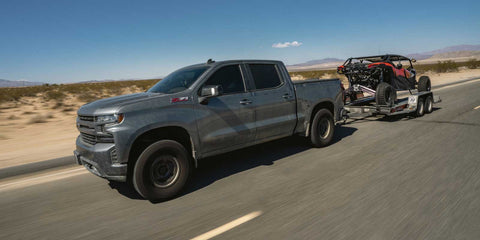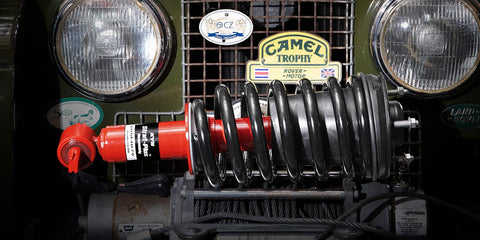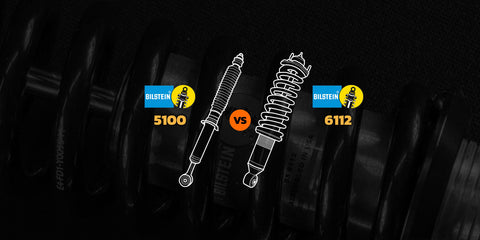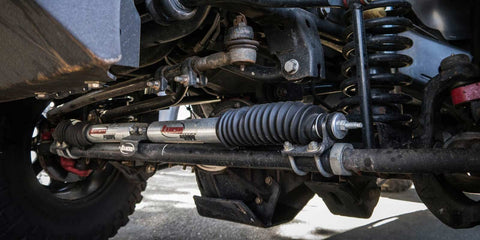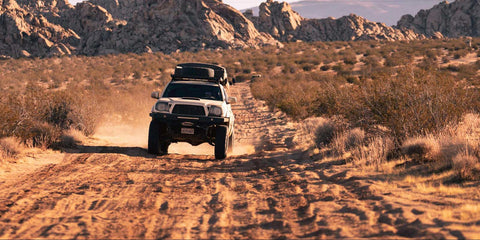Dobinsons MRR Shocks Unboxing - 3 Way Ride Control Adjustment
Posted by Sean Law-Bowman on
Although certainly not a new company, Dobinsons has seen a meteoric rise in popularity here in the States, and for good reason. For my fellow compatriots here in Bald Eagle Land who are not familiar with Dobinsons, they are an Australian brand that focuses on off-road suspension (particularly springs), accessories, armor, recovery gear, and just about everything you and your rig need to survive long treks through the Outback. Similar to their counterparts from down under, Ironman and OME, they look at upgrading your vehicle from holistic approach which often leads to a more cohesive package overall; especially if you are planning on armoring up and loading your rig down with gear.
Even if you run light, Dobinsons does a heck of a job, just like the other Aussies, making sure even their top-of-the-heap high-performance systems are still plenty plush when you are not going whole hog through the whoops and rollers.
We do not want to point fingers, but there are a lot of US-based brands that could stand to take a page from the Dobinsons manual. That doesn't mean these Dobinsons can’t hold up to some shenanigans if you are so inclined, or that the American stuff is necessarily uncomfortable, we simply find the Aussies are a shade better at striking a nice balance for the average Joe between comfort and performance.
The Kit Itself
Before we jump into the details we want to highlight Dobinsons' willingness to make parts for vehicle applications other than your typical Jeep or Tacoma. The particular kit we had the pleasure of unboxing this time around was their 1.75-3” lift MRR Kit for 2008-2022 Toyota Sequoias. However, specific dimensional data aside, most of what we are going over in this breakdown will be applicable to you regardless of which vehicle you run these Dobinsons MRR kits on. And trust us, the list of vehicle applications is longer than you would think.
Dobinsons MRR Kit Options
With any Dobinsons kit, MRR or otherwise, they give you some coil spring options, at least for the rear. In the case of this particular package, out back, you get the choice of part number C59-477 or the 2.5” coil we went with, part number C59-719V. The front uses a true threaded body coilover and comes with a 3” inner diameter (ID), 16” long, 650 lb/in universal coilover spring.
Although they do not give you any other options for springs, they allow for enough preload adjustment to go from as little as 2” or less of lift at stock weight or as high as 3” of lift with up to 175lbs of additional constant load over the front end. To take the guesswork out of setting them up, Dobinsons will preset the kit for your desired height or weight load, so you should not have to fiddle with preload when you get your kit.
| Lift Height | Constant Load | Pre Load Setting |
| 50mm - 2.0" | 0-85lb Load | 90mm |
| 50mm - 2.0" | 220-440lb Load | 100mm |
| 70mm - 2.75" | 220-440lb Load | 110mm |
| 75mm - 3.0" | 0-85lb Load | 103mm |
| 75mm - 3.0" | 110-175lb Load | 110mm |
Although having the kit preset certainly helps a ton, they are still an aluminum body. So even though they have a leg up on any steel body in the corrosion department, the fine aluminum threads will not hold up to adjustments made while installed on the vehicle. This means if plans change and you want to change your ride height or offset some sag from your shiny new bumper, winch, or skid plates, you will have to pull these puppies out and throw them on a spring compressor to make adjustments.
It is not uncommon for Dobinsons to only give you one spring option for applications that use a threaded body coilover, like these Sequoias, as you can largely get the ride height range and weight offset you need with the available preload adjustment on their coilovers. However, since they are a simple 3” ID universal spring, other rates and lengths are much more readily available from Dobinsons, Eibach, and just about every other spring manufacturer. So if you end up outside of the recommended weight range for these parts, a 700 lb/in or stiffer spring won’t be hard to find. In the case of everything else that might have a coil, leaf spring, or even a torsion bar separate from the shock, Dobinsons usually offers multiple “spring” options to accommodate different engine options, weight loads, and lift heights. If anything, you can pretty much expect to have the ability to really custom-tailor your kit to your specific needs.
Shock Talk
Our more experienced readers may have caught onto the fact that a 3” ID spring usually indicates that the shock body itself is around 2.5” in diameter, and you would be right. This particular kit uses 66mm or 2.6” bodies on both the front coilovers and rear shocks, but if your rig was not blessed with enough clearance for a shock body that thick, they do also offer these shocks in a 56mm or 2.2” body. So even if your rig can’t clear the big boy shocks, you can still probably bet on the fact you are getting the biggest body shocks that will fit without serious modification. That said, no matter the main shock body diameter, every single MRR shock gets a 60mm reservoir body, housing their low-speed and high-speed compression adjusters. More on those later.
Dobinsons maintains a 3mm wall thickness on all of their monotube dampers to keep them strong while ensuring overall weight stays in check. This means this particular package uses a 60mm or 2.36” diameter piston, so they should have plenty of potential dampening force on tap when you need it. If you have an application that uses a 56mm body shock, that means you get a 50mm piston, which is still plenty portly. Dobinsons is really known for their small bump compliance, and their high-flow piston design is definitely one of the key ingredients in their ride-quality recipe. The other crucial component in their witch's brew of shock magic is their 3 Way adjustable design, of which those high-flow pistons aid in not only their effectiveness as a whole but also their effective range of adjustment.
The pistons are definitely good stuff, but without a doubt, those three adjusters are truly the show's stars. Not only are these shocks on the extremely short list of shocks that include dual-speed compression adjusters, but they all sit in a class of their own for smooth-body monotube dampers by having rebound adjustment.
Compression Adjustment
On the compression side, DSCs have long been a main staple at Fox and Fox alone; however, many brands have adopted Fox’s design or similar for good reason. The Dobinsons perform and function in a very similar manner to just about everything else out there. Just like any other dual-speed compression adjuster, your low-speed compression clicker is largely going to control your brake dive, body roll, squat on the skinny pedal, and in some cases, the stiffness over long, soft, rolling bumps. In contrast, your high-speed knob will largely control bump stiffness, particularly over those bigger bone-rattling hits. Although vehicle speed can sometimes be a factor in whether a suspension event is considered either high-speed or low-speed, it is important to note we are talking about shock shaft speed and not how fast you are driving. For the sake of simplicity, just think of your high-speed knob as the comfort clicker and the low-speed knob as your control clicker. In the case of these MRRs, they have 10 clicks of High speed and 20 clicks of low speed, which will give you plenty of finite adjustment to get things dialed in to your preferences.
Rebound Adjustment
Just like with the DSC adjusters on the reservoirs, rebound damping is critical for both comfort and control. From a ride standpoint, you can really look at rebound as how your dampers are controlling the motions defined by your spring. You can use this adjuster to help reduce harsh top-outs at higher preload values or lift heights, as well as manage tire load and contact through dips where your suspension will need to extend. Since we specced this kit on the higher side in terms of preload and lift height, we will likely set up rebound a little tighter than we might if the suspension was set up lower.
Experience the ultimate in ride comfort with the best Way Ride Control Adjustment. Optimize your vehicle's performance using cutting-edge stock analytics for precise tuning. Elevate your driving experience to new heights with unparalleled control and analytics-driven adjustments.
On the handling front, you can use your rebound adjuster to control the dynamic weight shift across the chassis on and off the throttle or brakes and around corners to supplement your low-speed adjuster and to fine-tune the handling balance further. Using myself as an example, when I am hooning off-road, I often set the low speed compression adjuster to pretty much full stiff (If I have it) so that the rig slides before it sways violently. Since I am all but out of adjustment on low speed, I can then use the rebound clicker to finetune grip front to rear and, therefore, its propensity for understeering or oversteering at the limit.
These particular shocks feature 15 clicks of rebound adjustment, which gives you both a hefty total range of adjustment and the ability for fairly minute tweaks to really get it dialed in. The adjusters actually run along the inside of the shaft, so instead of using a knob on the reservoir like their DSCs, this particular set uses a small flathead screw at the end of the shock shaft near the top of the lower eyelet. In the case of shocks with a stud on the shaft side or coilovers that run an OE-style upper mount, the adjuster is located at the end of the stud.
Where applicable, Dobinsons also includes an “adjuster tool,” that looks and acts just like a knob, which slides onto the stud to make easier adjustments. The Sequoia kits and others with the flat head screw adjuster can use the included adjuster tool that also works on the DSCs, or as is implied, a flat head screwdriver. Overall, needing to grab a tool to adjust your shocks is certainly not as easy as turning a knob by hand, but Dobinsons uses a solid detent design so they offer a tactile click for each setting. And let's be frank here; tool required rebound adjustment beats the heck out of no rebound adjustment at all.
The Bottom Line
It is a really big plus in our book that they are making such high-end suspension solutions for platforms like these Sequoias that may not be as popular as your typical Tacoma or Wrangler. As those cars get more pricey and less attainable, there needs to be more support for the other guys, especially from brands that might do things a little differently.
Even if you ignore their 3-way adjustable design, which is certainly hard to do, Dobinsons definitely has a unique approach to the way they have engineered and tuned their parts that many of the bigger boys could afford to take note of. As always, keep your eyes peeled for a set of Dobies to make their way onto one, if not all, of the Shock Surplus rigs for some real-world testing and a thorough review, and of course, make sure to let us know what you are looking to see us dive into next.









